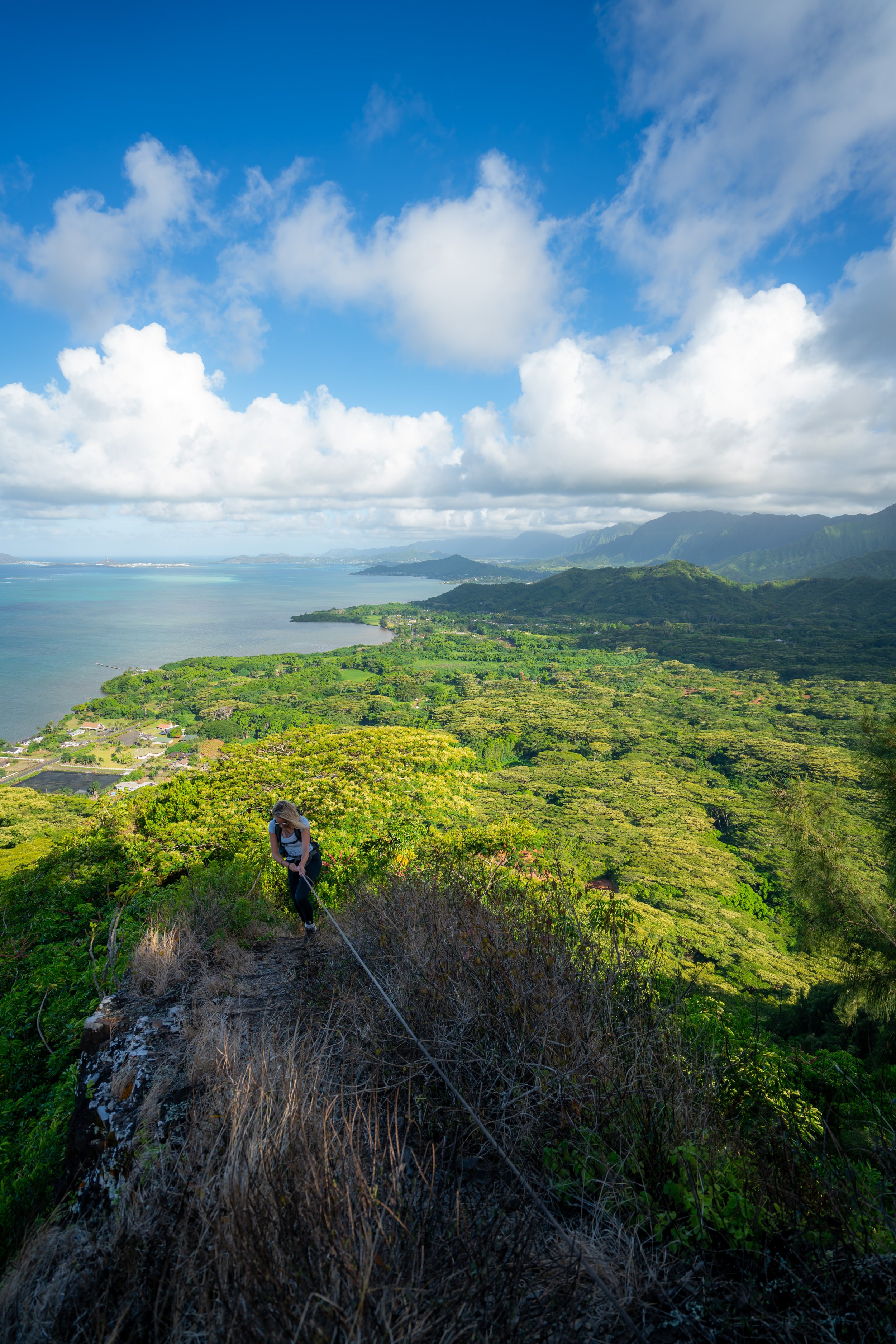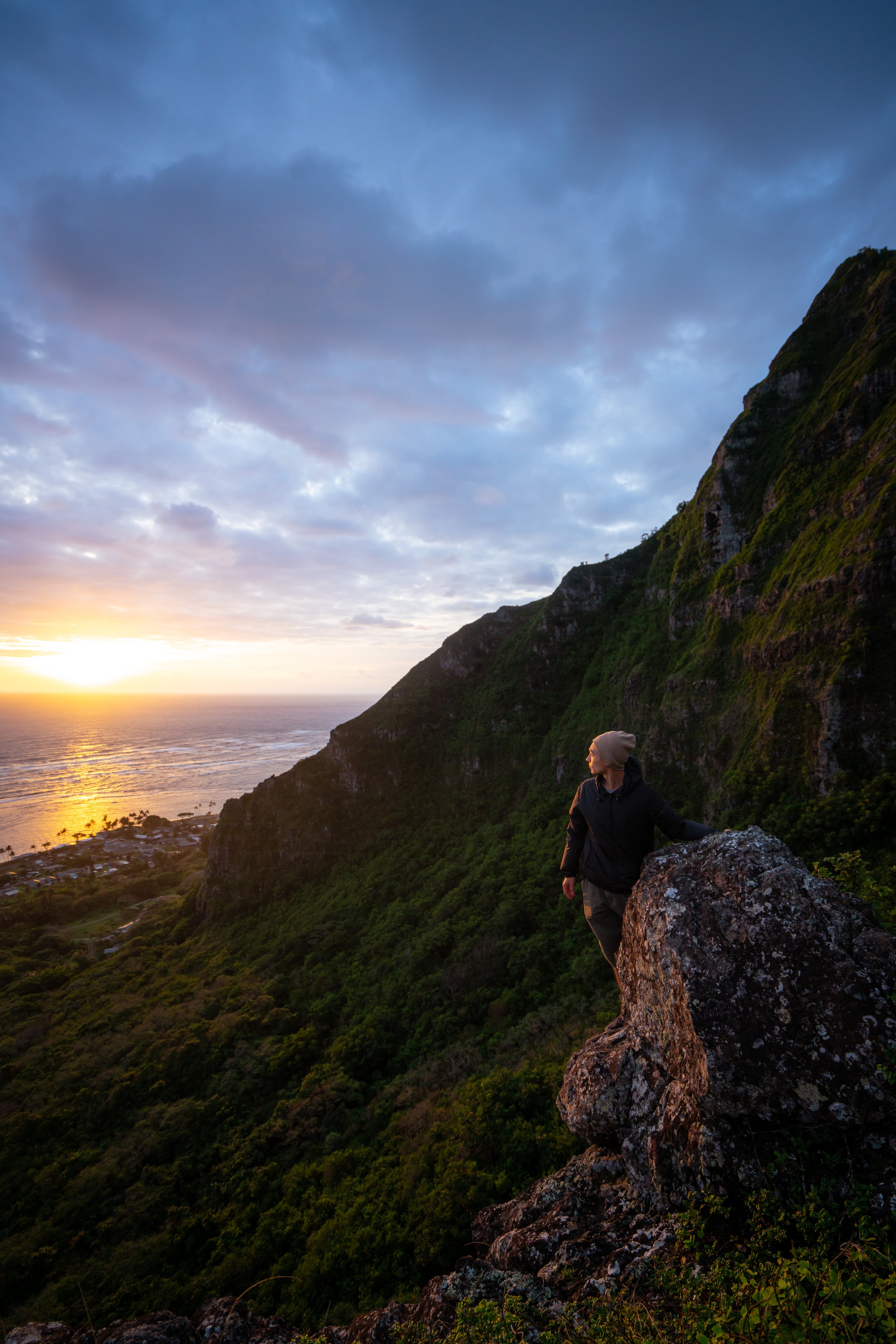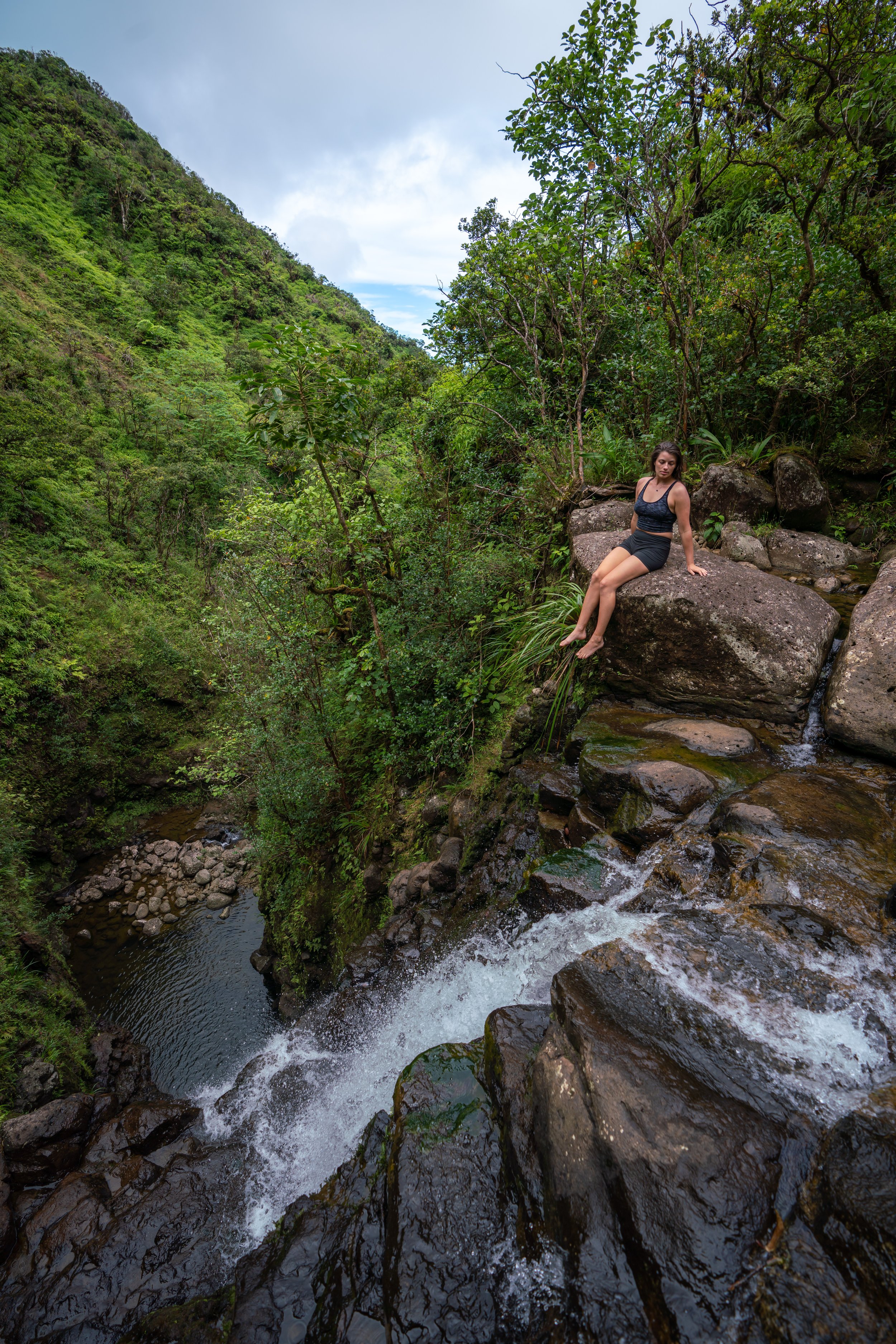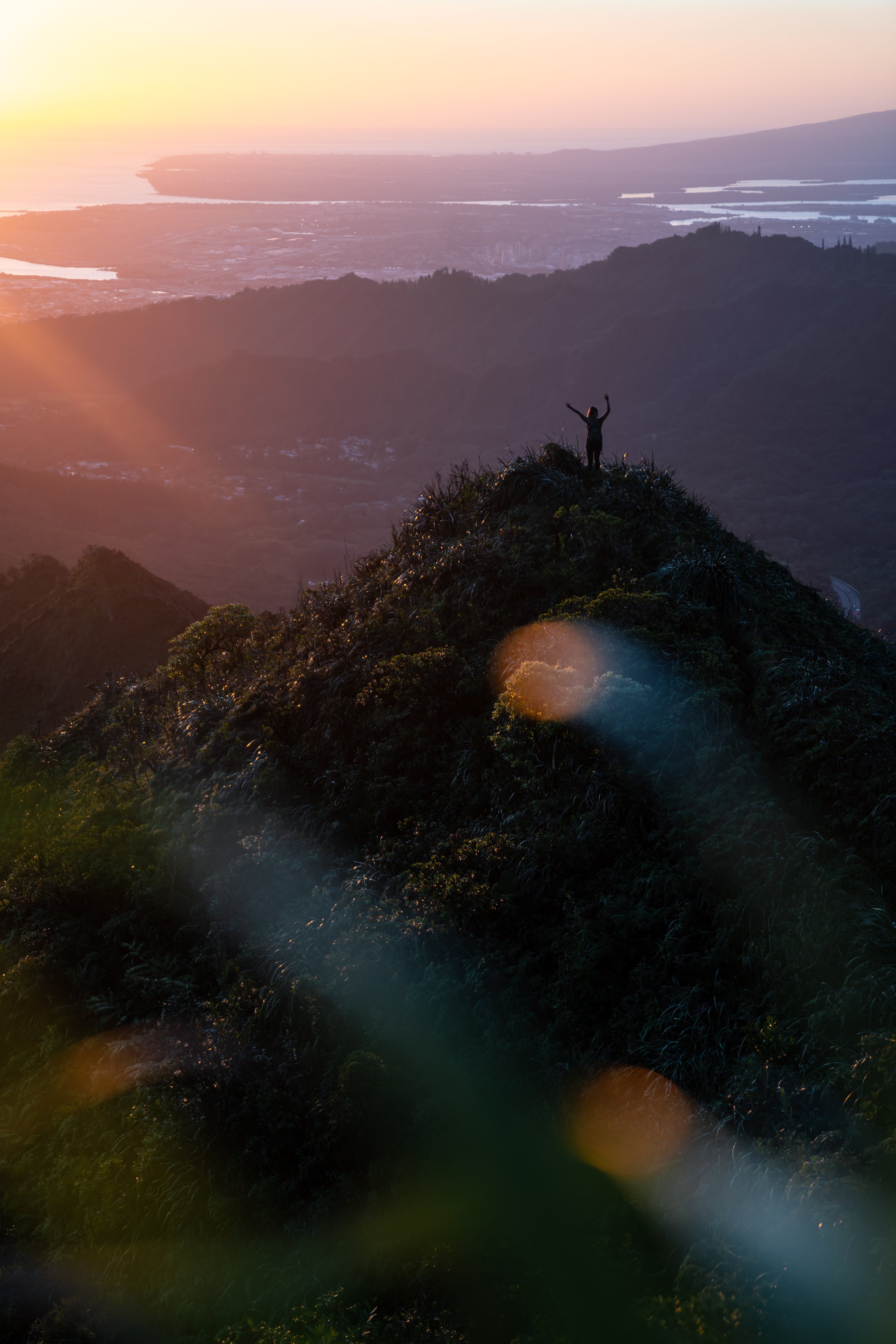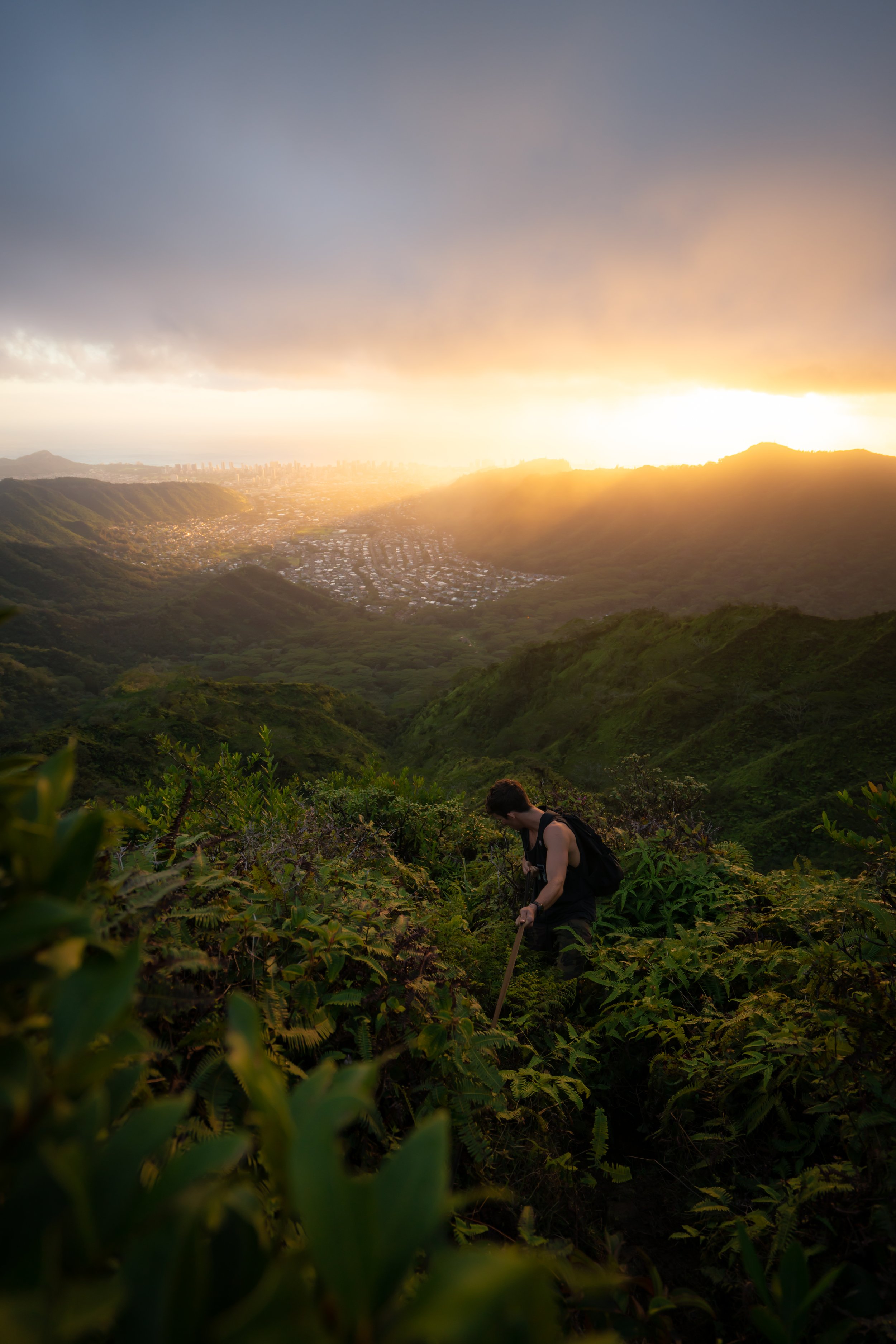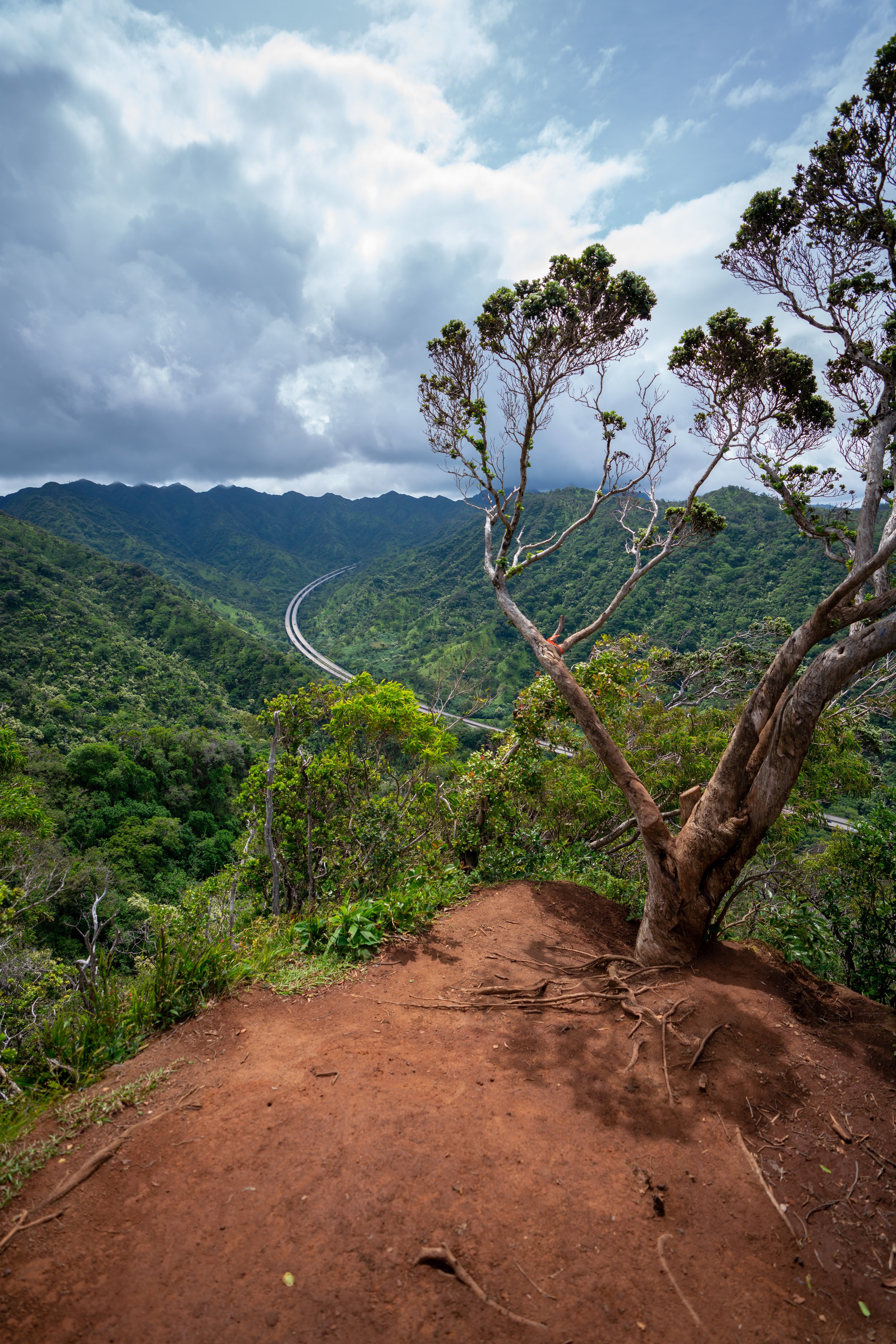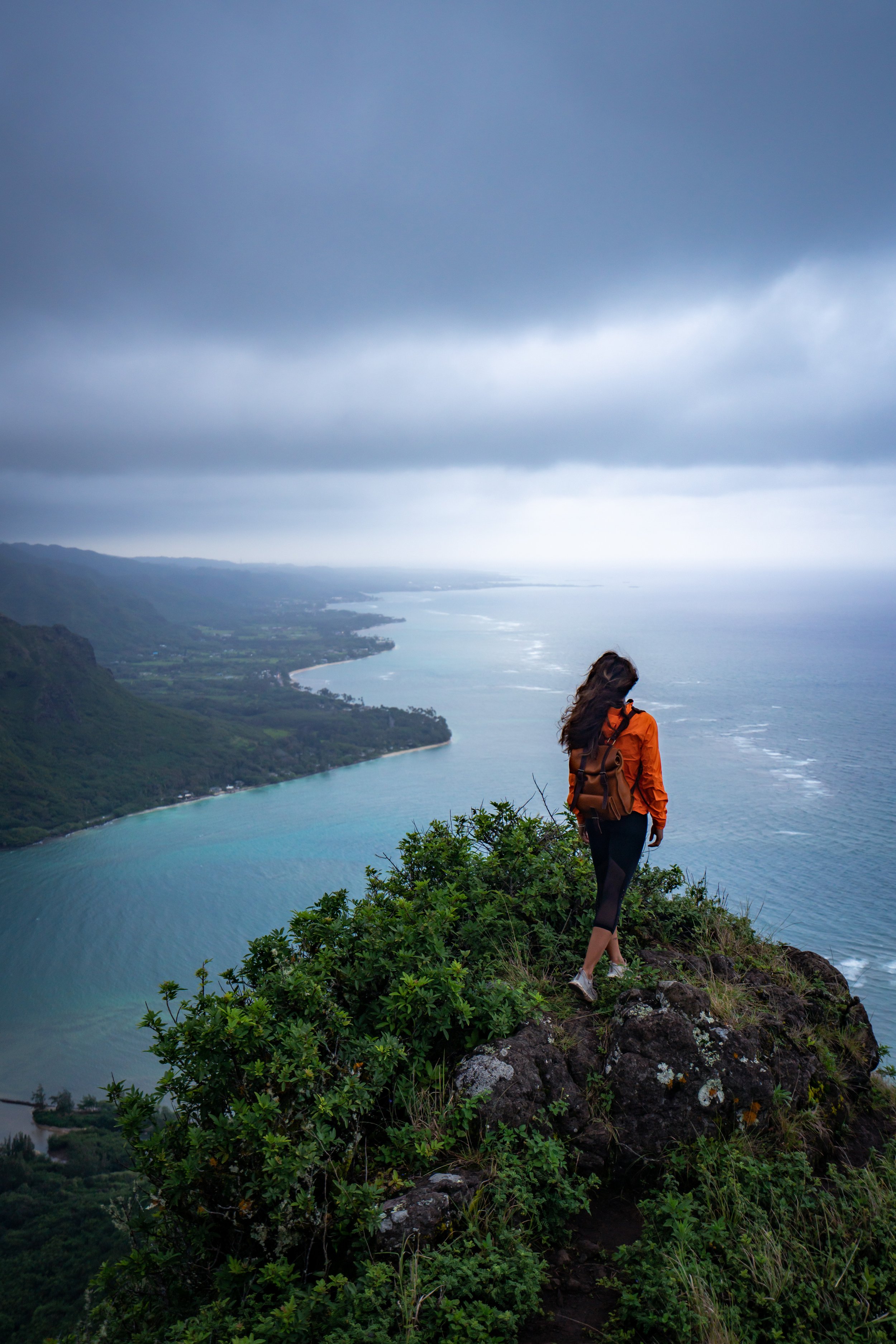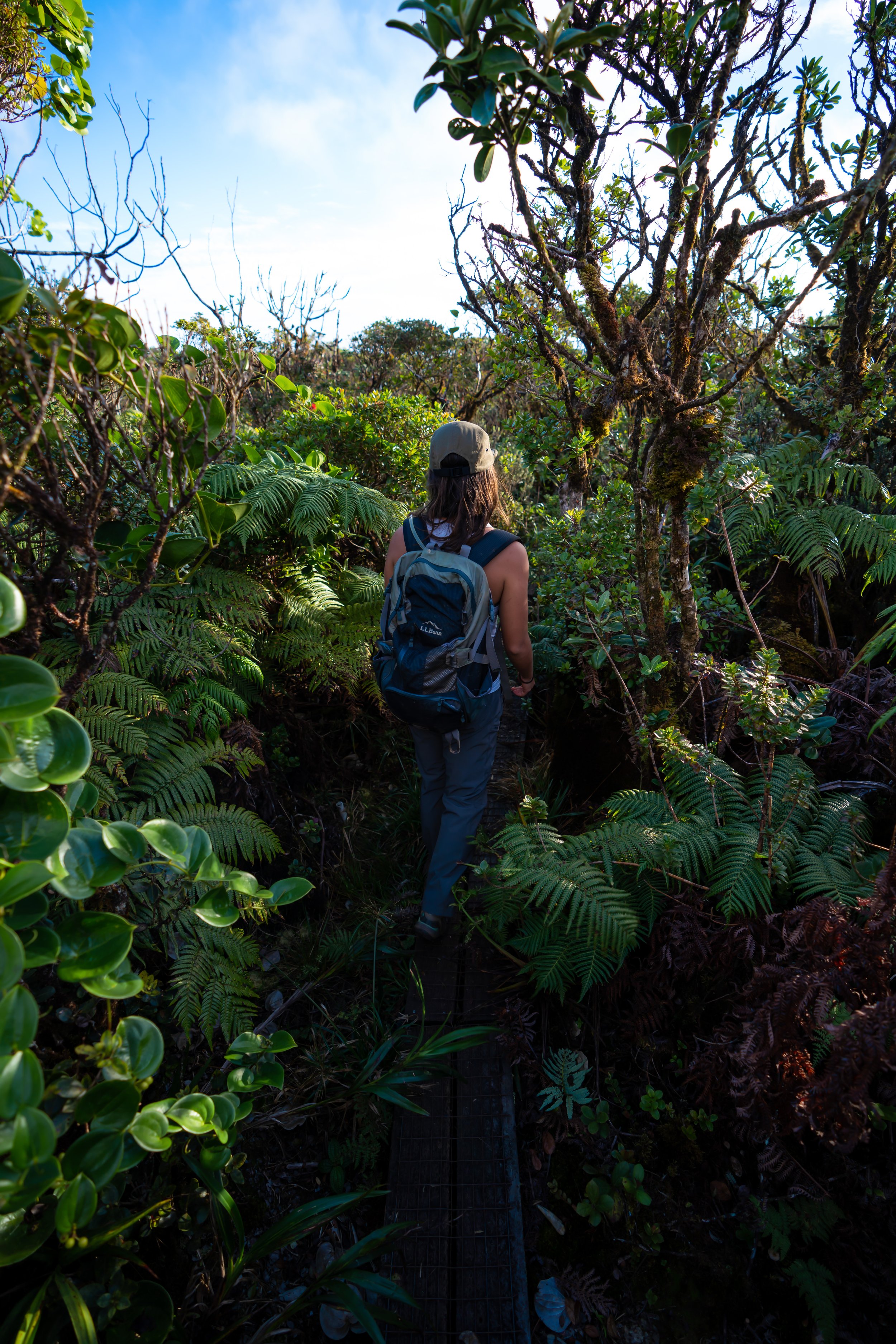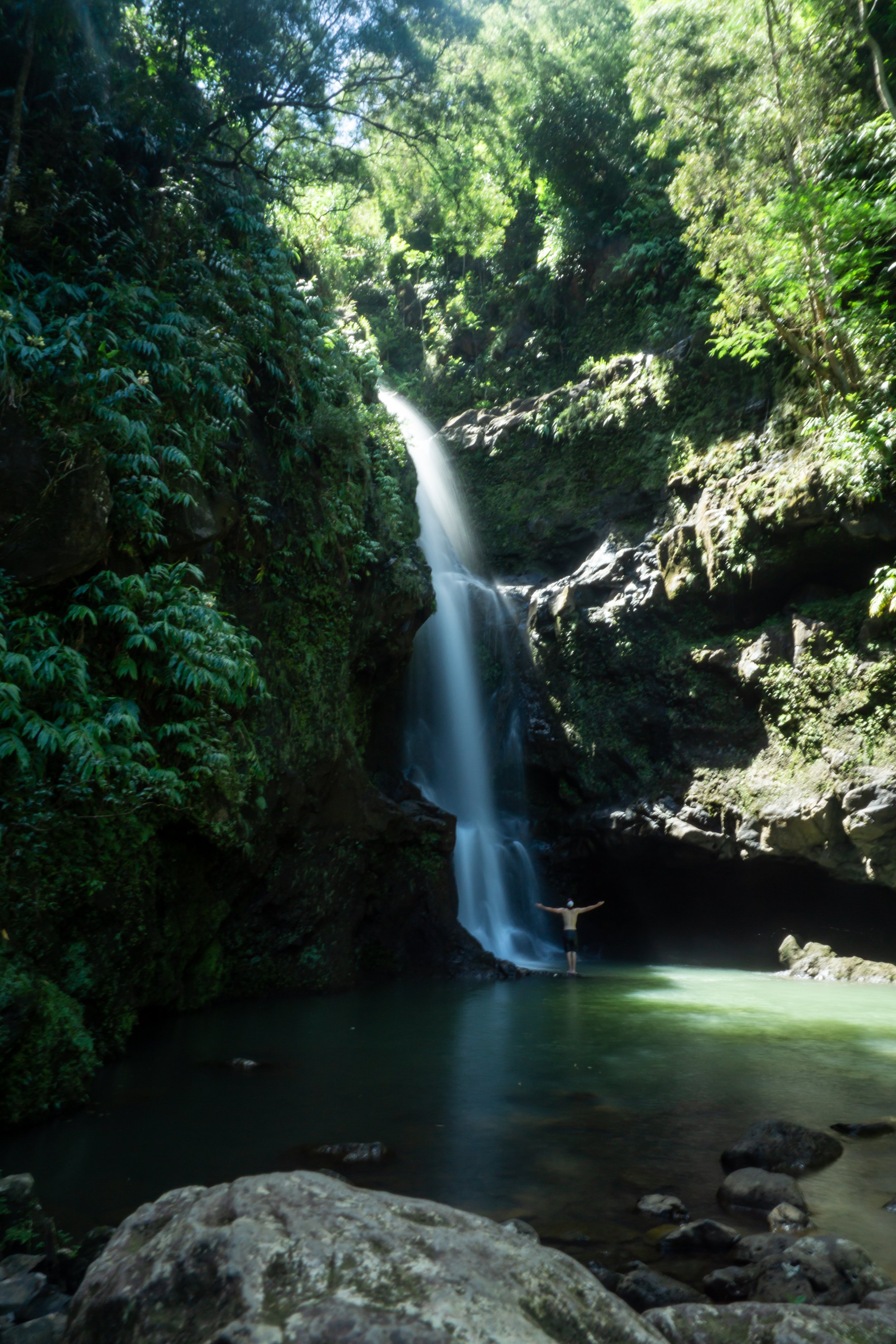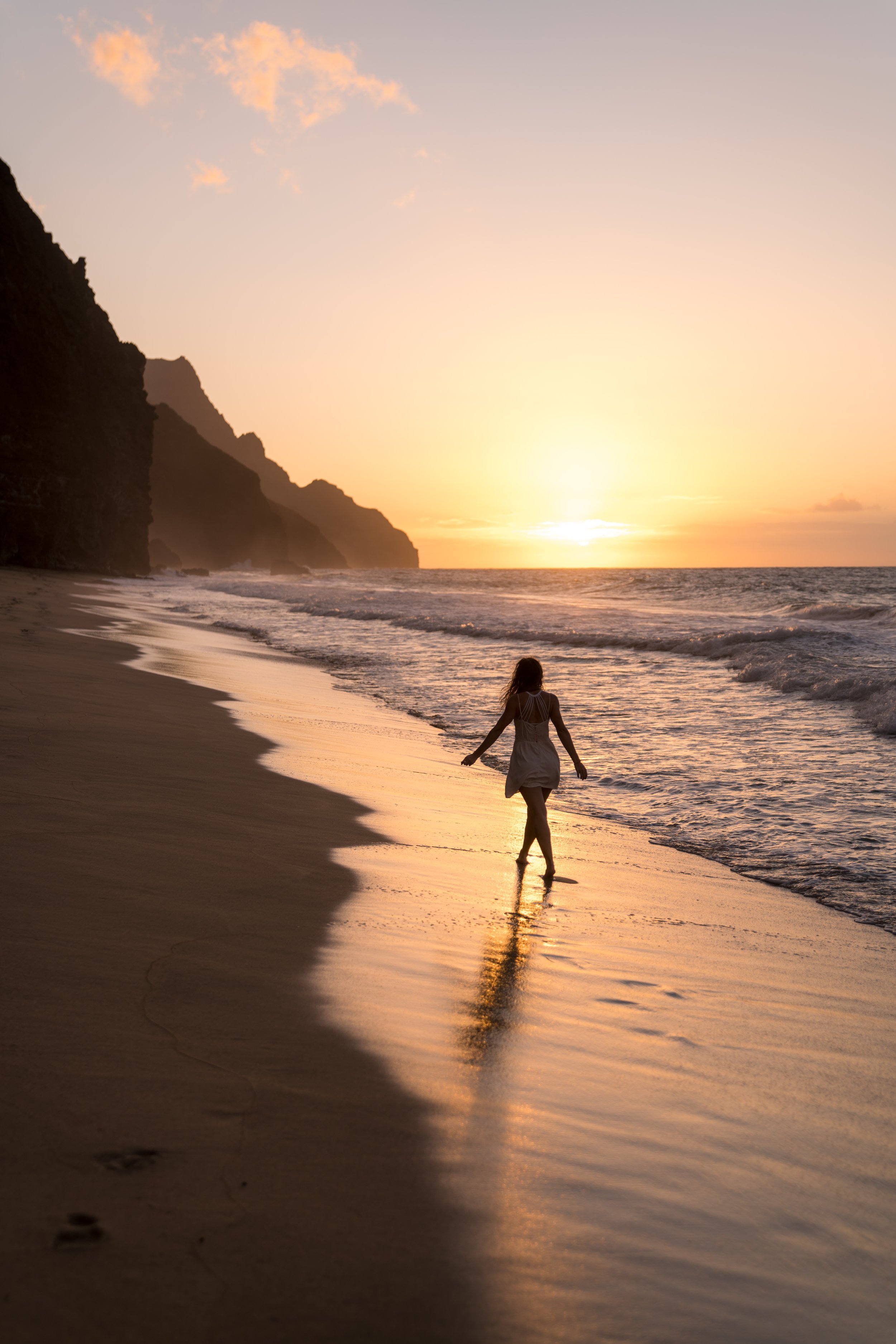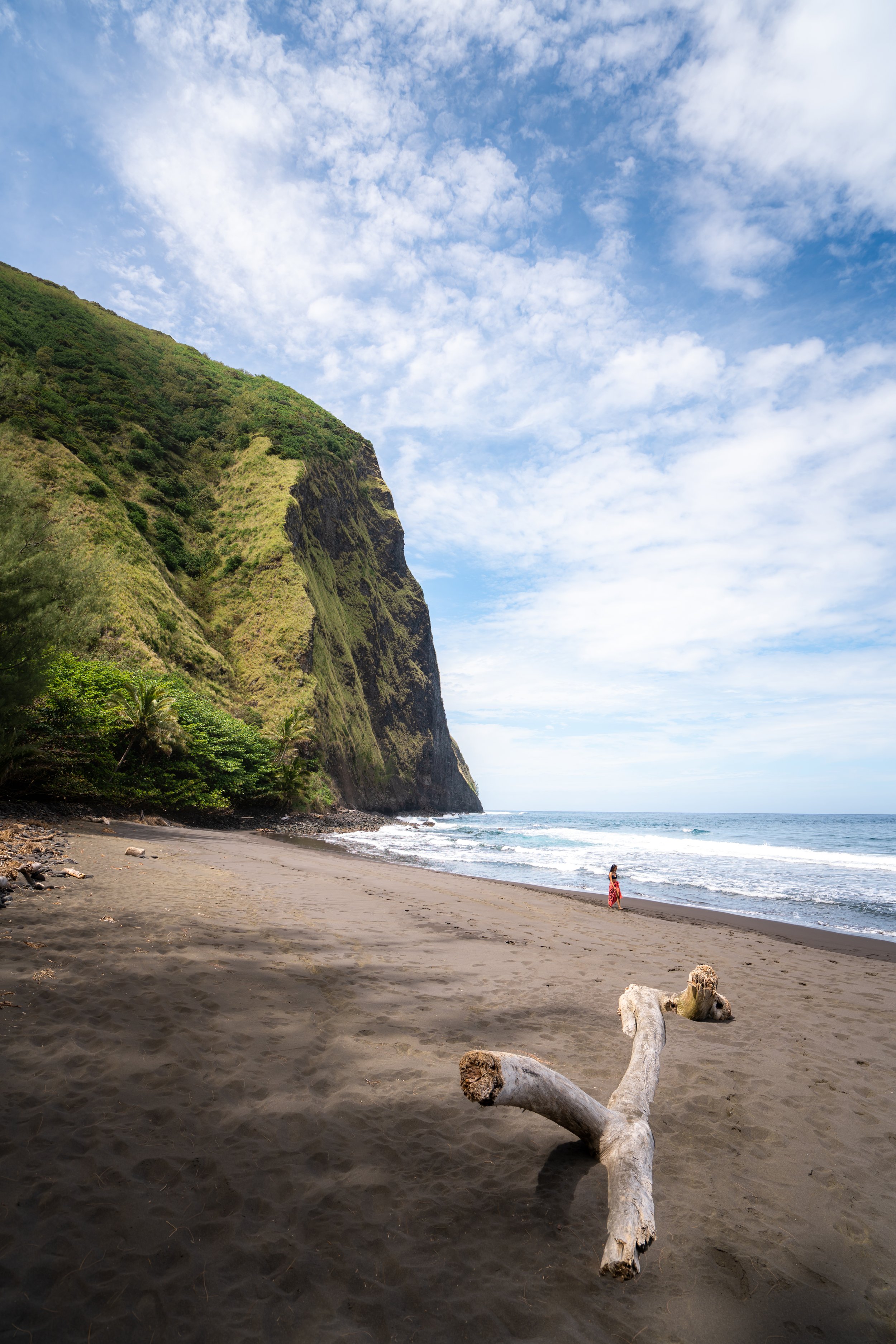Hiking the Pyramid Rock Loop Trail on Oʻahu, Hawaiʻi
Distance: 3.0 miles / 4.8 km
The Hahaiʻone Ridge Trail to Pyramid Rock, commonly called the Pyramid Rock Loop Trail, on Oʻahu is a beautiful, short but steep loop that makes for a fun and less-crowded alternative to other nearby Hawaiʻi Kai adventures, such as Kuliʻouʻou Ridge, Hawaiʻi Loa Ridge, and the Koko Crater Stairs.
That being said, Pyramid Rock is typically the sought-after destination that most hikers want to visit for the best views, which is why some may prefer to only hike up the Pyramid Rock Ridge Trail, instead of the full loop talked about here.
However, I almost exclusively prefer the Pyramid Rock Trail by way of Hahaʻione Ridge because the short loop with the Koʻolau Summit Trail (KST) is a great way to extend the short Pyramid Rock hike into a slightly longer 3.0-mile (4.8 km) adventure, while still beginning and ending at the same place.
Pyramid Rock Trailhead Parking
Parking for the Pyramid Rock Trail, as well as Hahaʻione Ridge, is located in the back of Hahaʻione Valley near the end of Hahaʻione Street.
That being said, both Hahaʻione and Pūkoʻo Street are two very quiet residential streets, which is why I ask that you please be quiet, respectful, park legally, and do not do anything that would draw negative attention to this local trailhead.
Google Maps Directions: Pyramid Rock Trailhead
My Hawaiʻi Hiking Checklist
Osprey 3L Water Bladder - The Osprey 3L water bladder is the most universal hiking and backpacking water bladder on the market, and it’s my go-to because of the slide-off seal that allows it to be quickly filled from the top. Additionally, individual parts are easily replaceable, such as the bite valve.
Blister / Heel Protectors - I swear by these cheap, amazing heel protectors to prevent blisters for nearly every kind of hiking and backpacking that I do!
Black Diamond Headlamp - Personally, I recommend the Black Diamond Storm because it is one of the brightest, lightest, and longest-lasting headlamps on the market—and trust me, the weight-to-battery-life ratio really does matter!
Hiking / Trail Running Shoes - Depending on the type of trail, I prefer to use either the Keen Targhee for longer, more rugged hiking or the HOKA Zinal Trail-Running Shoe for lighter, less intense trails. In either case, both have been amazing to me for many years across countless environments, and both can be found in men’s and women’s sizes. - (Men’s Keen / Women’s Keen) (Men’s HOKA / Women’s HOKA)
Waterproof Rain Shell - You never know when it may rain, and I’ve learned over the years that a rain shell is far better than a rain jacket. By this, I mean that it’s best to have something that the water will roll right off of, which is why I recommend the Patagonia Torrentshell 3L available in both men’s and women’s sizes.
High SPF Sunscreen - Packing high-SPF sunscreen is a must for long days outside!
Hiking the Pyramid Rock Loop Trail
The Hahaʻione-Pyramid Rock Loop Trail begins at the very end Hahaʻione Street.
Once on the trail, follow it straight back into Hahaʻione Valley until you reach the Pyramid Rock Loop, located about 0.1 miles (0.2 km) away.
Hahaʻione-Pyramid Rock Loop
At the split, the Hahaʻione Ridge Trail splits to the left, and the Pyramid Rock Ridge Trail splits to the right.
However, I recommend against accessing Pyramid Rock from this direction/ trailhead, which will make more sense from the photos at the end.
Through the lower forest in Hahaʻione Valley, the trail to the base of the ridge may seem a little confusing, but there is one central path to follow.
At this open area, take the trail on the right to continue toward Hahaʻione Ridge.
This is where the switchbacks begin and continue until the Hahaʻione Trail gains the ridge.
Hahaʻione Ridge
Once the trail reaches Hahaʻione Ridge, the hike will level off briefly, but eventually, the Hahaʻione Ridge will get steeper and steeper, as the hike nears Koʻolau Summit.
Hahaʻione-Kuliʻouʻou Junction
When the Hahaʻione Ridge Trail splits, go right to continue on the Pyramid Rock Loop.
The trail to the left is the Kuliʻouʻou Crossover, which is a completely different adventure that most hikers likely wouldn’t be interested in.
Hahaʻione Summit
The photos below are from the Hahaʻione Summit and the start of the Koʻolau Summit Trail (KST) that makes the loop with Pyramid Rock.
That being said, go right to hike south (right) on the KST to Pyramid Rock. The KST to the north (left) is the route that leads to Kuliʻouʻou.
For the most part, the KST portion of the Pyramid Rock Loop is fairly straightforward, with the exception of a few tricky turns right before Pyramid Rock.
Depending on the amount of maintenance, if any, the trail receives, the grass can be particularly overgrown near the power lines.
It’s always great to see the endemic Kokolau flower!
At about the 1.7-mile (2.7 km) mark, the tricky turns on the KST begin and continue until Pyramid Rock shortly ahead.
That being said, go around this tree on the left-hand side, and look for the trail that makes a sharp left turn off the ridge almost immediately after.
It will appear as if this isn’t the correct route at first, but if you don’t make this left and remain on the ridge, the ridgeline will cliff out, and you’ll be looking at Pyramid Rock, instead of being on Pyramid Rock.
The photos below show the hidden left turn that may be tricky to notice.
Following the section above, the KST will continue to descend until it comes to this very vague overgrown area in the photo below.
To continue toward Pyramid Rock, you need to go right on the not-so-obvious trail down this hillside, which will likely look less straightforward than staying on the ridge on the left.
At this rock feature, the Pyramid Rock Loop curves around on the windward side along a little skinny trail.
Next, at this split in the photo below, go right down the steep path.
The path going straight will cliff out shortly after.
Pyramid Rock-Koʻolau Summit Junction
The intersection in the photo below is where the Pyramid Rock Loop leaves the Koʻolau Summit Trail.
The trail to the left around the windward side is the route to continue along the KST, and the trail to the right is the best and easiest path to continue on to Pyramid Rock.
Read My Separate Post: Koʻolau Summit Trail (KST)
After the KST junction above, the Pyramid Rock Trail will begin the scramble up to Pyramid Rock itself.
In my opinion, this short section up and down Pyramid Rock on the Hahaʻione side is nothing more than a moderate class 2/ 3 scramble, but even still, a fall could have fatal consequences.
Pyramid Rock
Standing at roughly 1,550 ft. (472 m), Pyramid Rock is one of the most prominent summits above Hawaiʻi Kai, and from the top, you can get great views of Koko Head, Hanauma Bay, and much of the windward side across Waimānalo.
Pyramid Rock Ridge Trail
From the summit of Pyramid Rock, the trail down to Hahaʻione Valley descends a very steep trail, dropping roughly 1,200 ft. (366 m) in just over 0.6 miles (1.0 km).
From the top, the Pyramid Rock Trail initially drops off a fairly steep rock face, which is easiest to navigate to the left.
After this first drop, the rest of the Pyramid Rock Ridge Trail is more or less one steep path along the ridgeline until it comes to a fence just above the neighborhood.
Once at the fence, drop down to the trail below, and then you’ll have to decide between one of two options to return back to the beginning.
To complete the true Pyramid Rock Loop, there’s the option of following the trail when it splits to the right to hike back through Hahaʻione Valley to the initial junction show earlier.
However, the more popular and much more practical option is to follow the service road by simply cutting straight down the hillside until it reaches the road.
This option is typically more popular and faster of the two.
This service road will end on Pūkoʻo Street, which will be just a short walk away from where the Pyramid Rock Loop began.
Native Plants on the Pyramid Rock Loop
The Pyramid Rock Loop Trail is a relatively low-elevation trail, as far as the Koʻolau Mountains on Oʻahu are concerned, meaning this area is not the best place to find different native Hawaiian plants.
However, the few that I did notice were ʻŪlei, ʻUhaloa, Kokolau, Globe Schiedea, and ʻIlima.
If you would like to learn more about these and tons of other native Hawaiian plants from across the islands, I encourage you to check out my separate post linked below.
Read My Separate Post: Native Hawaiian Plant Guide
More Oʻahu Adventures
If you’re interested in reading about some more amazing Oʻahu adventures, check out my separate posts below!
Best Hotels & Restaurants in Waikīkī
If you’re trying to decided where to stay on Oʻahu, check out my top 10 list for the best resorts and restaurants in Waikīkī.
I break down what makes one hotel a better choice over another, so that you can find the best fit for your stay on the island.
Read My Separate Post: Best Waikīkī Hotels & Restaurants
HNL Airport-Hotel Shuttle
Prices on ride-share apps like Uber/ Lyft cannot beat the price of booking your hotel shuttle prior to arrival. I say this because there are additional fees for ride-share airport pick-ups at Honolulu Airport (HNL), which is why I recommend booking your transportation in advance using the options below.
Additionally, the last option below will go as far as the Ko ʻOlina Resorts on the West Side and Turtle Bay on Oʻahu’s North Shore!
Best Way to Book Rental Cars!
I travel quite a bit, and I know firsthand that finding a good rental car deal can be a challenge, but that’s why I recommend comparing all of your options with Discover Cars.
In short, Discover Cars is a well-known, reputable business that allows you to search for the best deal across companies, and they have the best full-refund cancellation policy I’ve ever seen, valid up to 72, or sometimes even 48, hours prior to your reservation!
Book Here: Discover Cars
Visiting Other Islands
If you are visiting Oʻahu or heading to another island, check out some of my personal recommendations for Oʻahu, Maui, Kauaʻi, Molokai, Lānaʻi, and Hawaiʻi Island (Big Island) in these separate posts.
If you’re trying to decide which island is right for your visit, check out my overview about each island in the post below.
Read My Separate Post: What is the Best Hawaiian Island to Visit?
What is the Best Time of Year to Visit Hawaiʻi?
The weather in Hawaiʻi can often appear to be warm and beautiful throughout the year, but in my experience, there is a lot more to consider when planning what time of year to visit the islands, such as what island you are considering, what sides of each island do you plan to stay, what activities are you most interested in, the wildlife, and countless other nuanced variables that can all impact the type of trip you can expect to have.
For these reasons, I highly recommend reading through my separate article to not only understand my thoughts regarding the best time of year to come to Hawaiʻi but also what you need to consider based on the time of year that you plan to visit.
Read My Separate Post: What is the Best Time of Year to Visit Hawaiʻi?
10 Best Tours & Excursions on Oʻahu
There are a lot of different tour options to choose from on Oʻahu, but to make it easier to decide, I made a list of my favorite tours because some things simply are better with a local guide!
Read My Separate Post: Best Tours on Oʻahu
Safety
All hikes in Hawaiʻi should not be compared to trails outside of the islands, and hikers should exercise due caution on every adventure, given that many are extremely dangerous.
By this, I mean that Hawaiʻi is known for hot, humid weather, steep, dramatic, and unstable cliffs, and flash floods, which can occur without warning. Therefore, it is important that you check the local forecast, understand the physical condition of your entire group, and pack sufficient food and water before attempting any adventure.
Disclaimer
All information provided on this blog is for informational purposes only and is not intended to be a substitute for information or advice from qualified professionals or managing agencies.
Noah Lang Photography LLC makes no representations or warranties regarding the accuracy or completeness of the information provided here, and readers should use their own discretion, judgement, and seek professional advice where it is appropriate.
Furthermore, Noah Lang Photography LLC shall not be held responsible for any injuries, lost individuals, or legal issues arising from the use of information provided on this website, and if applicable, the above safety disclaimer should be referenced to provide a generic overview of the risks involved.
All said, the content on this blog is for the sole use of Noah Lang Photography LLC, and unauthorized use or reproduction of this content is strictly prohibited.
Disclosure
This post is not sponsored.
However, some of the links in this post are affiliate links, which means that I may earn a small commission if a purchase is made through one of those links. This commission comes at no additional cost to you, and I only recommend products that I personally use and believe will add value to my readers. Thank you for your support, which enables me to continue creating more!
To read the full privacy policy, click here.

About This Blog
Noah Lang Photography, also known as @noahawaii, is 100% reader-supported!
I do not accept guest articles or sponsored content of any kind on my blog, which is why, if you enjoy the outdoor and travel content I create, please consider buying me a coffee!
I appreciate your support, which helps me continue to keep this blog alive!










